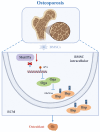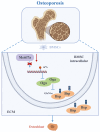Mettl7a alleviated bone loss in osteoporosis mice by targeting the O-GlcNAcylation of Bsp via m6A methylation
- PMID: 40558384
- PMCID: PMC12188527
- DOI: 10.1093/stcltm/szaf024
Mettl7a alleviated bone loss in osteoporosis mice by targeting the O-GlcNAcylation of Bsp via m6A methylation
Abstract
Postmenopausal osteoporosis, a prevalent metabolic bone disease, elevates susceptibility to fragility fractures while imposing substantial healthcare costs and public health challenges. The profound interplay between BMSCs and surrounding extracellular matrix (ECM) proteins, which are highly rich in O-GlcNAcylation, play pivotal roles in the process of osteoporosis. M6A methylation plays a crucial regulatory role in the development of osteoporosis, while the crosstalk between m6A methylation and ECM O-GlcNAcylation remains mechanistically undefined. Here we found Mettl7a overexpression improved the impaired osteogenic capability of OVX-mBMSCs in vitro. Conditional knockout of Mettl7a in the mesenchyme (Prx1-cre;Mettl7af/f) accelerated bone loss of OVX mice. Mechanistically, Mettl7a promoted mBMSCs osteogenic differentiation by targeting the O-GlcNAcylation of Bsp, an ECM protein. Mettl7a regulated the expression and O-GlcNAcylation of Bsp through m6A methylation of Oga. We further demonstrated that Mettl7a-AAV treatment alleviated bone loss phenotype in osteoporosis mice via the O-GlcNAcylation of Bsp. Collectively, our findings reveal novel mechanistic intersections between ECM protein O-GlcNAcylation and m6A methylation, advancing the understanding of osteoporotic regulation.
Keywords: Mettl7a; O-GlcNAcylation; extracellular matrix (ECM); m6A methylation; osteoporosis.
© The Author(s) 2025. Published by Oxford University Press.
Conflict of interest statement
The authors declare no conflict of interest.
Figures








Similar articles
-
NSD2-mediated H3K36me2 exacerbates osteoporosis via activation of hoxa2 in bone marrow mesenchymal stem cells.Cell Signal. 2024 Sep;121:111294. doi: 10.1016/j.cellsig.2024.111294. Epub 2024 Jul 10. Cell Signal. 2024. PMID: 38996954
-
O-GlcNAcylation of METTL3 drives hepatocellular carcinoma progression by upregulating MCM10 expression in an m6A-IGF2BP3-dependent manner.Cell Death Dis. 2025 Jul 12;16(1):518. doi: 10.1038/s41419-025-07844-1. Cell Death Dis. 2025. PMID: 40651967 Free PMC article.
-
Bone marrow mesenchymal stem cells (BMSCs)-derived exosomal METTL3 regulates the m6A methylation of SMAD5 to promote osteogenic differentiation of osteoblasts.Connect Tissue Res. 2025 May;66(3):204-215. doi: 10.1080/03008207.2025.2496832. Epub 2025 Apr 29. Connect Tissue Res. 2025. PMID: 40298375
-
Emerging Roles of Protein O-GlcNAcylation in Bone Remodeling: New Insights Into Osteoporosis.Acta Physiol (Oxf). 2025 Aug;241(8):e70080. doi: 10.1111/apha.70080. Acta Physiol (Oxf). 2025. PMID: 40665904 Review.
-
N6-Methyladenosine Modification of the Three Components "Writers", "Erasers", and "Readers" in Relation to Osteogenesis.Int J Mol Sci. 2025 Jun 12;26(12):5620. doi: 10.3390/ijms26125620. Int J Mol Sci. 2025. PMID: 40565084 Free PMC article. Review.
References
-
- Crandall CJ, Larson J, Wright NC, et al. Serial bone density measurement and incident fracture risk discrimination in postmenopausal women. JAMA Intern Med. 2020;180:1232-1240. https://doi.org/ 10.1001/jamainternmed.2020.2986 - DOI - PMC - PubMed
-
- Yong EL, Logan S.. Menopausal osteoporosis: screening, prevention and treatment. Singapore Med J. 2021;62:159-166. https://doi.org/ 10.11622/smedj.2021036 - DOI - PMC - PubMed
-
- Barron RL, Oster G, Grauer A, Crittenden DB, Weycker D.. Determinants of imminent fracture risk in postmenopausal women with osteoporosis. Osteoporos Int. 2020;31:2103-2111. https://doi.org/ 10.1007/s00198-020-05294-3 - DOI - PMC - PubMed
-
- Compston JE, McClung MR, Leslie WD.. Osteoporosis. Lancet. 2019;393:364-376. https://doi.org/ 10.1016/S0140-6736(18)32112-3 - DOI - PubMed
-
- Reid IR, Billington EO.. Drug therapy for osteoporosis in older adults. Lancet. 2022;399:1080-1092. https://doi.org/ 10.1016/S0140-6736(21)02646-5 - DOI - PubMed
MeSH terms
Substances
Grants and funding
LinkOut - more resources
Full Text Sources
Medical
Miscellaneous

